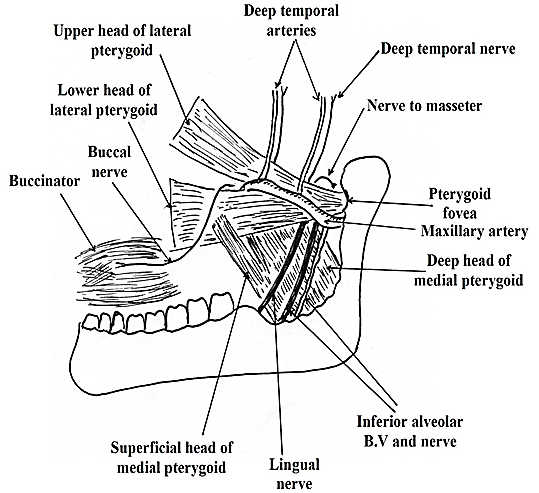Temporal & infratemporal region of human body anatomy l General anatomy MCQ (multiple choice question) for dental student
MCQ on temporal and infratemporal region for general anatomy
1. Which of the following nerves is related to the neck of the mandible? *
A.
Auriculotemporal nerve.
B.
Buccal nerve.
C.
Chorda tympanic nerve.
D.
Lingual nerve.
E. Inferior
alveolar nerve.
2. The nerve supply to the muscles of mastication exits the skull through foramen? *
A.
Carotid canal.
B.
Foramen lacerum.
C.
Foramen magnum.
D.
Foramen ovale.
E. Jugular foramen.
3. Which of the following nerves lies just behind and below the third molar tooth?? *
A.
Auriculotemporal.
B.
Buccal.
C.
Chorda tympani.
D.
Inferior alveolar.
E.
Lingual.
4. Regarding the action of the muscles of mastication. Which is true? *
A.
Temporalis and masseter muscles open the mouth
B.
Contraction of the medial pterygoid moves the mandible to
the opposite side
C.
The lateral pterygoid retracts the mandible
D.
Muscles attached to both mandibular processes help in
opening the mouth
E.
The posterior fibers of the temporalis protrude the mandible
5- Which nerve carries the general sensation from gingiva of the hard palate? *
A.
The greater superficial petrosal nerve
B.
The lesser superficial petrosal nerve
C.
The nasociliary nerve
D.
The nerve in the greater palatine canal
E.
The nerve of the pterygoid canal
6. Which of the following is true
regarding the pterygopalatine ganglion?
A.
All fibers entering or leaving the ganglion have synapses
within the ganglion
B.
It contains sympathetic fibers from the lesser petrosal
nerve
C.
It is the largest autonomic ganglion in the head and neck
D.
It lies immediately posterior to the pterygoid process of
the sphenoid bone
E.
Its sensory root originates from the mandibular nerve
7. The sensory branch of the mandibular nerve to the dura of the middle cranial fossa enters the skull through which foramen? *
A.
Inferior orbital fissure
B.
Jugular
C.
Ovale
D.
Rotundum
E. Spinosum
8. Which of the following area is supplied by maxillary nerve? *
a)
Skin at the tip of the nose
b)
Skin of the forehead
c)
Skin of the lower eyelid
d)
Skin of the medial angle of the cye
e)
Skin of the upper eyelid
9. Regarding the tempromandibular joint: *
a)
It is a synovial pivot joint-
b)
It is supplied by the great auricular nerve
c)
Its articular disc is attached to the medial pterygoid
d)
The head of mandible articulates with pterygoid fossa
e)
The lateral pterygoid muscle is a-powerful protractor
10. Regarding the maxillary artery: *
a)
Begins superficial to the neck of the mandible
b)
Conveys parasympathetic fibers in its periarterial nerve
plexus
c)
Enters the infratemporal fossa through the pterygomaxillary
fissure
d)
It is the source of oxygenated blood to all mandibular
foramen
e)
Supplies the lacrimal gland
11- Regarding the medial pterygoid muscle: *
a)
Attached to the medial pterygoid plate
b)
Depresses the mandible
c)
Has an attachment to the maxilla
d)
Inserted in the mandible above the mandibular nerve
e)
Supplied by branches from the anterior division of the
mandibular nerve
12- Regarding the lingual nerve: *
a)
Is lateral to the lateral pterygoid muscle
b)
Is lateral to the medial pterygoid muscle
c)
Is medial to the ramus of the mandible
d)
Receives sensory fibers from the mandibular teeth
e)
Sends motor fibers to the anterior belly of the digastrics
13. Which of the following is the most powerful protractor of the temporomandibular joint T.M.J ? *
a)
Anterior fibers of the temporalis
b)
Lateral pterygoid
c)
Masseter
d)
Medial pterygoid
e)
Posterior fibers of the temporalis
14. Regarding the temporomandibular joint (TMJ): *
a)
Articular surfaces are covered by hyaline cartilage
b)
Has the tendon of medial pterygoid muscle attached to the
joint capsule and the neck of the mandible
c)
Is a ball and socket joint
d)
Is supplied by the ariculotemporal nerve
e) The head of the mandible articulates with pterygoid fossa
15. Regarding the muscles of mastication
A.
Temporalis and masseter open the mouth.
B.
Side-to-side chewing movements are achieved by the alternate
movement of the pterygoids.
C.
The medial pterygoid is attached to the medial pterygoid
plate.
D.
All muscles are supplied by the seventh cranial nerve.
E.
The posterior fibers of the temporalis protrude the
mandible.
16. Incapacity to protrude the mandible indicates a dysfunction of which muscle?
A.
Anterior belly of digastrics
B.
Buccinator
C.
Lateral pterygoid
D.
Mylohyoid
E.
Temporalis
17. Incapacity to retract the mandible indicates a dysfunction of which muscle?
A.
Medial Pterygoid
B.
Buccinator
C.
Lateral pterygoid
D.
Genioglossus
E.
Temporalis
18. Which muscle is NOT supplied by the mandibular division of the trigeminal nerve?
A.
Anterior belly of digastrics
B.
Stylohyoid
C.
Medial pterygoid
D.
Mylohyoid
E.
Temporalis
19. Which of the following muscles does not tend to close the jaws:
A.
Internal (medial) pterygoid .
B.
External (lateral) pterygoid .
C.
Masseter . D. Temporalis .
D.
None of the above (A-D) e.g. All tend to close the jaw
20. Which of the following muscles is not innervated by the trigeminal nerve:
A. Masseter .
B. Buccinator
C. Internal (medial)
pterygoid .
D. Temporalis
E. External (lateral)
pterygoid .







0 Comments